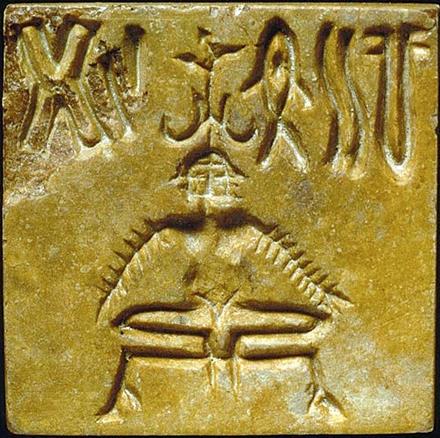Mirror: http://tinyurl.com/pqrd958
Characteristic hieroglyph-multiplex is noticed on many artifacts across Eurasia, on seals in particular, depicting a man ligatured to the hindpart of a bovine. This hypertext has been deciphered on Indus Script Corpora as artisan working with smelters, furnaces and in smithy/forge, that is, a metalsmith or metalcaster. The so-called conflict narratives are in fact archaeometallurgical explorations and inventions of new metal alloys and metalcasting techniques.
A characteristic representation of bull-man occurs on many Sumerian/Mesopotamian artifacts and cylinder seals. This hieroglyph-multiplex has its roots in the hieroglyphs used on Indus Script Corpora which display horned persons with the hindparts of a bovine and wearing headdress of a twig which in Indus Script cipher is kūdī 'bunch of twigs' (Sanskrit) Rebus: kuṭhi
'smelter furnace' (Santali) कूदी [p= 300,1] f. a bunch of twigs , bunch (v.l. कूट्/ई) AV. v , 19 , 12 Kaus3.ccord. to Kaus3. , Sch. = बदरी, "Christ's thorn".(Monier-Williams).
The bul-man hieroglyph-multiplex is thus an artisan working in metal and with smelters/furnaces. Mth. ṭhākur ʻ blacksmith ʼ (CDIAL 5488) N. ḍāṅro ʻ term of contempt for a blacksmith ʼ S. ḍhaṅgaru m. ʻ lean emaciated beast ʼ ; L. (Shahpur) ḍhag̠g̠ā ʻ small weak ox ʼ(CDIAL 5324) These words in the Proto-Prakritam lexis provide the rebus-metonymy renderings leading to bull-men orthography.

On Pict-103, a decrepit woman with hanging breasts is ligatured to the hindpart of a bovine signifying a blacksmith. dhokra 'decrepit woman' Rebus: dhokra 'cire perdue metalcasting artisan'.
Hieroglyph: eṛaka 'upraised arm' (Tamil); rebus: eraka = copper (Kannada) eraka 'molten cast' (Tulu) 'metal infusion' (Kannada)
kuTi 'tree' Rebus: kuThi 'smelter'
kamaDha 'archer' Rebus: kampaTTa 'mint'
Hieroglyph: ḍhaṅgaru, ḍhiṅgaru m. ʻlean emaciated beastʼ(Sindhi) Rebus: dhangar ‘blacksmith’ (Maithili)
Hieroglyph: karava 'pot with narrow neck' karNaka 'rim of jar' Rebus: kharva 'nidhi, wealth, karba 'iron'; karNI 'supercargo' karNIka 'scribe'.
Mohenjo-daro seal (2500-2000 BCE) showing a seated yogi with horns of a buffalo showing a twig (pipal branch?) growing out from between them. http://www.harappa.com/indus/33.html

Molded tablets from Trench 11 sometimes have impressions on one, two, three or four sides. This group of molded tablets shows the complete set of motifs. One side is comprised entirely of script and has six characters, the first of which (on the very top) appears to be some sort of animal. A second side shows a human figure grappling with a short horned bull. A small plant with at least six branches is discernible behind the individual. The third panel portrays a figure seated on a charpoy or throne in a yogic position, with arms resting on the knees. Both arms are covered with bangles, and traces of a horned headdress and long hair are visible on some of the impressions. A second individual, also with long hair and wearing bangles, is seated on a short stool to the proper left of the individual on the "throne." The fourth panel shows a deity standing with both feet on the ground and wearing a horned headdress. A branch with three pipal leaves projects from the center of the headdress. Bangles on seen on both arms
Mohenjo-daro. Square seal depicting a nude male deity with three faces, seated in yogic position on a throne, wearing bangles on both arms and an elaborate headdress. Five symbols of the Indus script appear on either side of the headdress which is made of two outward projecting buffalo style curved horns, with two upward projecting points. A single branch with three pipal leaves rises from the middle of the headdress.
Seven bangles are depicted on the left arm and six on the right, with the hands resting on the knees. The heels are pressed together under the groin and the feet project beyond the edge of the throne. The feet of the throne are carved with the hoof of a bovine as is seen on the bull and unicorn seals. The seal may not have been fired, but the stone is very hard. A grooved and perforated boss is present on the back of the seal.
Material: tan steatite Dimensions: 2.65 x 2.7 cm, 0.83 to 0.86 thickness Mohenjo-daro, DK 12050
Islamabad Museum, NMP 50.296 Mackay 1938: 335, pl. LXXXVII, 222
Hieroglyph: kamaḍha ‘penance’ (Pkt.) Rebus 1: kampaṭṭa ‘mint’ (Ma.) kamaṭa = portable furnace for melting precious metals (Te.);Rebus 2: kaṇḍa ‘fire-altar' (Santali); kan ‘copper’ (Ta.)
Hieroglyph: karã̄ n. pl. ʻwristlets, bangles ʼ (Gujarati); kara 'hand' (Rigveda) Rebus: khAr 'blacksmith' (Kashmiri)
The bunch of twigs = ku_di_, ku_t.i_ (Skt.lex.) ku_di_ (also written as ku_t.i_ in manuscripts) occurs in the Atharvaveda (AV 5.19.12) and Kaus’ika Su_tra (Bloomsfield’s ed.n, xliv. cf. Bloomsfield, American Journal of Philology, 11, 355; 12,416; Roth, Festgruss an Bohtlingk,98) denotes it as a twig. This is identified as that of Badari_, the jujube tied to the body of the dead to efface their traces. (See Vedic Index, I, p. 177).[Note the twig adoring the head-dress of a horned, standing person]
Mahadevan concordance Field Symbol 83: Person wearing a diadem or tall
head-dress standing within an ornamented arch; there are two stars on either
side, at the bottom of the arch.मेढ (p. 662) [ mēḍha ] 'the polar star' (Marathi) Rebus: meḍ 'iron' (Ho.Mu.)
head-dress standing within an ornamented arch; there are two stars on either
side, at the bottom of the arch.मेढ (p. 662) [ mēḍha ] 'the polar star' (Marathi) Rebus: meḍ 'iron' (Ho.Mu.)
When a phoneme evokes more than one image, the artist who creates the glyptic representations uses ligatures. Thus, ko_la = woman (Nahali) kol = tiger (Santali). The representation in glyptic are yields a ligature of a woman and a iger. Ash.kū́l.Ə ‘child,
foetus’, istrimalī—kul.ä́ ‘girl’; Kt. kŕū, kuŕuk ‘young of animals’; Pr. kyuru ‘young of animals, child’, kyurú ‘boy’, kurı̄́ ‘colt, calf’; Dm. kúŕa ‘child’, hum. Kul.; Kal. kūŕ *l k ‘young of animals’; Phal. Kul.ī̆‘woman, wife’; K. kūrü f. ‘young girl’, kash. Kōl.ī, ram. Kul.hī; L. kul.ā m. ‘bridegroom’, kul.ī f. ‘girl, virgin, bride’, kul.ī f. ‘woman’; P. kul.ī f. ‘girl, daughter’, P. WPah. khaś. kul.i, cur. Kul.ī, cam. ko;l.ā ‘boy’, kuṛī ‘girl’ (CDIAL 3245). Kur..antai ‘child’ (Tamil) kola ‘woman’ (Nahali. Assamese).
foetus’, istrimalī—kul.ä́ ‘girl’; Kt. kŕū, kuŕuk ‘young of animals’; Pr. kyuru ‘young of animals, child’, kyurú ‘boy’, kurı̄́ ‘colt, calf’; Dm. kúŕa ‘child’, hum. Kul.; Kal. kūŕ *l k ‘young of animals’; Phal. Kul.ī̆‘woman, wife’; K. kūrü f. ‘young girl’, kash. Kōl.ī, ram. Kul.hī; L. kul.ā m. ‘bridegroom’, kul.ī f. ‘girl, virgin, bride’, kul.ī f. ‘woman’; P. kul.ī f. ‘girl, daughter’, P. WPah. khaś. kul.i, cur. Kul.ī, cam. ko;l.ā ‘boy’, kuṛī ‘girl’ (CDIAL 3245). Kur..antai ‘child’ (Tamil) kola ‘woman’ (Nahali. Assamese).
It appears that the person holding back the two rearing jackals on the tablet is a woman: ko_l ‘woman’ (Nahali);dual. ko_lhilt.el (Sudhibhushan Bhattacharya, Field-notes on Nahali, Ind. Ling. 17, 1957, p. 247); kola = bride, son’s (younger brother’s) wife
(Kui) ko_l is a phonetic determinative of the two jackals, kol ‘tiger’; rebus:
kol ‘metal’ (Ta.) Rebus: kol ‘pancaloha’ (Tamil) m1186 seal. The rice plant adorning
(Kui) ko_l is a phonetic determinative of the two jackals, kol ‘tiger’; rebus:
kol ‘metal’ (Ta.) Rebus: kol ‘pancaloha’ (Tamil) m1186 seal. The rice plant adorning
the curved horn of the person (woman?) with the 'scarf' pig-tail is kolmo; read
rebus, kolme ‘smithy’. Smithy of what? Kol ‘pancaloha’. The curving horn is:
kod.u = horn; rebus: kod. artisan’s workshop (Kuwi) dhatu 'scarf' Rebus: dhatu 'mineral' (Santali) https://kalyan97.wordpress.com/2007/06/29/mleccha-written-read-rebus/
rebus, kolme ‘smithy’. Smithy of what? Kol ‘pancaloha’. The curving horn is:
kod.u = horn; rebus: kod. artisan’s workshop (Kuwi) dhatu 'scarf' Rebus: dhatu 'mineral' (Santali) https://kalyan97.wordpress.com/2007/06/29/mleccha-written-read-rebus/
showing Sarasvati hieroglyphs].
m305 A person with a plaited pigtail, bangles/armlets on both hands from wrist to shoulder, seated in penance, with three faces, two stars on either side of the curved buffalo-horn and twig. "The seal depicting seven (or six) robed figures with pig-tails and stylized twigs on their heads, for instance, is routinely interpreted as the seven (or six) presiding deities of Pleiades. K provides an additional, possible reading of the seal as pertaining to the goldsmith’s portable furnace + native metal (p. 197-199, 430)...An Indus seal showing a horned male person seated in yoga like posture figures in many text books assigned to courses on Indian religions, history, and civilization. A three-leaved branch of the Pipal tree appears on his crown with a star on either side. Two stars adorn the curved buffalo horns of the seated person who wears a scarf on pigtail. Seven bangles are depicted on the left arm and six on the right, with the hands resting on the knees. The heels are pressed together under the groin and the feet project beyond the edge of the throne. In the considered opinion of the scholarly community, the person in the seal represents (a) a yogi or an ascetic practicing meditation or engaged in austerities or penance; (b) a proto-Rudra/Shiva or (c) Agni, the god of fire...Without disputing this line of interpretation, K suggests that the seal may have additional information to communicate in the field of metallurgy. The word in Prakrit for penance is kamandha, which is homonymous with the Tamil ord kampattam meaning ‘mint. The word for large horns with sweeping upward curve as applied to buffalos is dabe in Santali. The words dab, dhimba, dhombo meaning a lump (clot) are homonyms for dabe. The word for twig in the Atharvaveda (5:19.12) is kudi. A Santali word kuthi meaning ‘smelting furnace’ would be a homonym for kudi. Another Santali
word kote meaning ‘forged’ [metal] is also relevant here. After analyzing other glyptic elements on the seal, K concludes that the person on the seal is a lapidary scribe working in a mint (p. 188 and personal communication from K)." From: Solving the Indus script puzzle: A review of Indus Script Cipher by Dr S. Kalyanraman By Shrinivas Tilak* (Sept. 9,
2010) https://sites.google.com/site/kalyan97/indus-script-cipher
2010) https://sites.google.com/site/kalyan97/indus-script-cipher
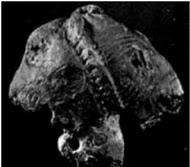 Terracotta. Tiger, bovine, elephant, Nausharo NS 92.02.70.04 h. 6.76 cm; w. 4.42; l. 6.97 cm. Centre for Archaeological Research Indus Balochistan, Musée Guimet, Paris
Terracotta. Tiger, bovine, elephant, Nausharo NS 92.02.70.04 h. 6.76 cm; w. 4.42; l. 6.97 cm. Centre for Archaeological Research Indus Balochistan, Musée Guimet, Paris harappa.com "Slide 88. Three objects (harappa.com) Three terra cotta objects that combine human and animal features. These objects may have been used to tell stories in puppet shows or in ritual performances. On the left is a seated animal figurine with female head. The manner of sitting suggests that this may be a feline, and a hole in the base indicates that it would have been raised on a stick as a standard or puppet. The head is identical to those seen on female figurines with a fan shaped headdress and two cup shaped side pieces. The choker with pendant beads is also common on female figurines. Material: terra cotta Dimensions: 7.1 cm height, 4.8 cm length, 3.5 cm width Harappa, 2384 Harappa Museum, HM 2082 Vats 1940: 300, pl. LXXVII, 67 In the center is miniature mask of horned deity with human face and bared teeth of a tiger. A large mustache or divided upper lip frames the canines, and a flaring beard adds to the effect of rage. The eyes are defined as raised lumps that may have originally been painted. Short feline ears contrast with two short horns similar to a bull rather than the curving water buffalo horns. Two holes on either side allow the mask to be attached to a puppet or worn as an amulet.
harappa.com "Slide 88. Three objects (harappa.com) Three terra cotta objects that combine human and animal features. These objects may have been used to tell stories in puppet shows or in ritual performances. On the left is a seated animal figurine with female head. The manner of sitting suggests that this may be a feline, and a hole in the base indicates that it would have been raised on a stick as a standard or puppet. The head is identical to those seen on female figurines with a fan shaped headdress and two cup shaped side pieces. The choker with pendant beads is also common on female figurines. Material: terra cotta Dimensions: 7.1 cm height, 4.8 cm length, 3.5 cm width Harappa, 2384 Harappa Museum, HM 2082 Vats 1940: 300, pl. LXXVII, 67 In the center is miniature mask of horned deity with human face and bared teeth of a tiger. A large mustache or divided upper lip frames the canines, and a flaring beard adds to the effect of rage. The eyes are defined as raised lumps that may have originally been painted. Short feline ears contrast with two short horns similar to a bull rather than the curving water buffalo horns. Two holes on either side allow the mask to be attached to a puppet or worn as an amulet. Material: terra cotta Dimensions: 5.24 height, 4.86 width Harappa Harappa Museum, H93-2093 Meadow and Kenoyer, 1994 On the right is feline figurine with male human face. The ears, eyes and mouth are filled with black pigment and traces of black are visible on the flaring beard that is now broken. The accentuated almond shaped eyes and wide mouth are characteristic of the bearded horned deity figurines found at Harappa and Mohenjo-daro (no. 122, 123). This figurine was found in a sump pit filled with discarded goblets, animal and female figurines and garbage. It dates to the final phase of the Harappan occupation, around 2000 B. C.
Harappa, Lot 5063-1 Harappa Museum, H94-2311 Material: terra cotta Dimensions: 5.5 cm height, 12.4 cm length, 4.3 cm width
 "... head and torso of a human but the horns, lower body and legs of a bull...Baked clay plaques like this were mass-produced using moulds in southern Mesopotamia from the second millennium BCE. British Museum. WCO2652. Bull-manTerracotta plaque. Bull-man holding a post. Mesopotamia, ca. 2000-1600 BCE."
"... head and torso of a human but the horns, lower body and legs of a bull...Baked clay plaques like this were mass-produced using moulds in southern Mesopotamia from the second millennium BCE. British Museum. WCO2652. Bull-manTerracotta plaque. Bull-man holding a post. Mesopotamia, ca. 2000-1600 BCE." Terracotta. This plaque depicts a creature with the head and torso of a human but the horns, lower body and legs of a bull. Though similar figures are depicted earlier in Iran, they are first seen in Mesopotamian art around 2500 BC, most commonly on cylinder seals, and are associated with the sun-god Shamash. The bull-man was usually shown in profile, with a single visible horn projecting forward. However, here he is depicted in a less common form; his whole body above the waist, shown in frontal view, shows that he was intended to be double-horned. He may be supporting a divine emblem and thus acting as a protective deity.
Old Babylonian, about 2000-1600 BCE From Mesopotamia Length: 12.8 cm Width: 7cm ME 103225 Room 56: Mesopotamia
Baked clay plaques like this were mass-produced using moulds in southern Mesopotamia from the second millennium BCE. While many show informal scenes and reflect the private face of life, this example clearly has magical or religious significance.
Hieroglyph carried on a flagpost by the blacksmith (bull ligatured man: Dhangar 'bull' Rebus: blacksmith'): karava 'pot with narrow neck' karNaka 'rim of jar' Rebus: kharva 'nidhi, wealth, karba 'iron'; karNI 'supercargo' karNIka 'scribe'.
 ROM accession number 994.233.17, is made of serpentine and is 3.5 x 2.2 cm. It dates to the Akkadian period in Mesopotamia (about 2200 BCE). Royal Ontario Museum.The seal depicts a typical contest scene: a nude bearded hero fights a bull while a lion fights a bearded bull-man. The inscription identifies the seal's owner as "Shu-ili-su, the beer-maker". Shu-ilishu is the name of the Akkadian interpreter of Meluhha on another seal.
ROM accession number 994.233.17, is made of serpentine and is 3.5 x 2.2 cm. It dates to the Akkadian period in Mesopotamia (about 2200 BCE). Royal Ontario Museum.The seal depicts a typical contest scene: a nude bearded hero fights a bull while a lion fights a bearded bull-man. The inscription identifies the seal's owner as "Shu-ili-su, the beer-maker". Shu-ilishu is the name of the Akkadian interpreter of Meluhha on another seal.
The rollout of Shu-ilishu's Cylinder seal. Courtesy of the Department des Antiquites Orientales, Musee du Louvre, Paris.
A Mesopotamian cylinder seal referring to the personal translator of the ancient Indus or Meluhan language, Shu-ilishu, who lived around 2020 BCE during the late Akkadian period. http://a.harappa.com/content/shu-ilishus-cylinder-seal..
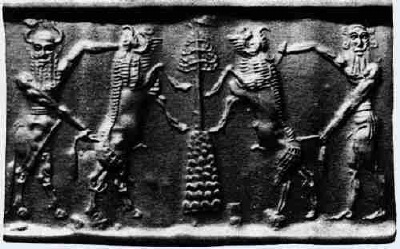
Akkadian cylinder-seal impression of a bull-man and hero. Each is holding a bull by the horns, and in the centre is a stylised mountain with a sacred tree on top.

Cylinder seal: Ht. 3.6 cm. 2,220 - 2,159 BCE, Mesopotamia (Photo from pg. 216 of J. Aruz and R. Wallenfels (eds.) 2003 Art of the First Cities) Nude Bearded Hero and Water Buffalo; Bull-Man Fighting Lion Serpentine It is remarkable that this seal also shows, in the centre of the pictorial scene, a 'twig' a typical indus script pictorial motif (or what I call, Indus script hieroglyph).
Reading of the pictorial motif of leaf on summit:
loha dhatu dangra kūṭa, 'copper mineral smith forge guild (workshop)'.
Hieroglyphs are read rebus. Glyphs of the writing system by smiths who invented alloying:
loha 'ficus leaf';
dhatu 'leaf petioles';
dangra 'bull';
Pk. ḍhaṁkhara -- m.n. ʻ branch without leaves or fruit ʼ (CDIAL 5524)
kūṭa 'summit'. (cf. kot.e meD 'forged iron'; meD 'antelope' (Mu.)
The 'bull men' glyphs denote dhangar 'smiths'; dul dhangar 'two smiths'; rebus: cast (metal)
smiths. (Thus, this pictorial motif of leaf on summit is a phonetic determinant of the two glyptic motifs on either side).
smiths. (Thus, this pictorial motif of leaf on summit is a phonetic determinant of the two glyptic motifs on either side).
kūṭamu = summit of a mountain (Telugu)
Rebus: kūṭakamu =mixture (Te.lex.) kūṭam = workshop (Ta.) The Sign 230 thus connotes an alloyed metal, kūṭa [e.g. copper + dhātu ‘mineral (ore)’ as in: ārakūṭa = brass
(Skt.)]
(Skt.)]
Vikalpa
ṭākuro = hill top (N.); ṭāngī = hill, stony country (Or.); ṭān:gara = rocky hilly land (Or.); ḍān:gā = hill, dry upland (B.); ḍā~g = mountain-ridge (H.)(CDIAL 5476).
डगर [ ḍagara ] f A slope or ascent (as of a river's bank, of a small hill). 2 unc An eminence, a mount, a little hill (Marathi). Rebus: ḍān:ro = a term of contempt for a blacksmith (N.)(CDIAL 5524). ṭhākur = blacksmith (Mth.) (CDIAL 5488).
daṭhi, daṭi the petioles and mid-ribs of a compound leaf after the leaflets have been plucked
off, stalks of certain plants, as Indian corn, after the grain has been taken off (Santali)
off, stalks of certain plants, as Indian corn, after the grain has been taken off (Santali)
Rebus: dhātu ‘mineral’ (Vedic); a mineral, metal (Santali); dhāta id. (G.)
loa = a species of fig tree, ficus glomerata, the fruit of ficus glomerata (Santali.lex.)
Homophone
Hierolyph: lo = nine (Santali); no = nine (B.) on-patu = nine (Ta.) Rebus: lo ‘iron’
(Assamese, Bengali); loa ‘iron’ (Gypsy) lauha = made of copper or iron (Gr.S'r.); metal, iron (Skt.); lōhakāra = coppersmith, ironsmith (Pali); lōhāra = blacksmith (Pt.); lohal.a (Or.); lōha = metal, esp. copper or bronze (Pali); copper (VS.); loho, lō = metal, ore, iron (Si.) lōhá ʻ red, copper -- coloured ʼ ŚrS., ʻ made of copper ʼ ŚBr., m.n. ʻ copper ʼ VS., ʻ iron ʼ MBh.[*rudh -- ] Pa. lōha -- m. ʻ metal, esp. copper or bronze ʼ; Pk. lōha -- m. ʻ iron ʼ,
Gy. pal. li°, lihi, obl. elhás, as. loa JGLS new ser. ii 258; Wg. (Lumsden) "loa"ʻ steel ʼ; Kho. loh ʻ copper ʼ; S. lohu m. ʻ iron ʼ, L. lohā m., awāṇ.lōˋā, P. lohā m. (→ K.rām. lohā),WPah.bhad. lɔ̃u n., bhal. lòtilde; n.,pāḍ. jaun. lōh, paṅ. luhā, cur. cam. lohā,
Ku. luwā, N. lohu, °hā, A. lo,B. lo, no, Or. lohā, luhā,Mth. loh, Bhoj. lohā, Aw.lakh.lōh, . loh, lohā m.,G. M. loh n.; Si. loho, lō ʻmetal, ore, iron ʼ; Md. ratu -- lō ʻ copper ʼ. *lōhala -- , *lōhila --, *lōhiṣṭha -- , lōhī -- , laúha -- ; lōhakāra -- , *lōhaghaṭa -- , *lōhaśālā-- , *lōhahaṭṭika -- , *lōhōpaskara -- ; vartalōha -- . Addenda: lōhá --: WPah.kṭg. (kc.) lóɔ ʻ iron ʼ, J. lohā m.,
Ku. luwā, N. lohu, °hā, A. lo,B. lo, no, Or. lohā, luhā,Mth. loh, Bhoj. lohā, Aw.lakh.lōh, . loh, lohā m.,G. M. loh n.; Si. loho, lō ʻmetal, ore, iron ʼ; Md. ratu -- lō ʻ copper ʼ. *lōhala -- , *lōhila --, *lōhiṣṭha -- , lōhī -- , laúha -- ; lōhakāra -- , *lōhaghaṭa -- , *lōhaśālā-- , *lōhahaṭṭika -- , *lōhōpaskara -- ; vartalōha -- . Addenda: lōhá --: WPah.kṭg. (kc.) lóɔ ʻ iron ʼ, J. lohā m.,
Garh. loho; Md. lō ʻ metal ʼ.†*lōhaphāla -- or†*lōhahala -- . (CDIAL 11158)
lōhakāra m. ʻ iron -- worker ʼ, °rī -- f., °raka -- m. lex., lauhakāra -- m. Hit. [lōhá -- ,
kāra -- 1] Pa. lōhakāra --m. ʻ coppersmith, ironsmith ʼ; Pk. lōhāra -- m. ʻ blacksmithʼ, S. luhā̆ru m., L. lohār m., °rī f.,awāṇ. luhār, P. WPah.khaś. bhal. luhār m.,Ku. lwār, N. B. lohār, Or. lohaḷa, Bi.Bhoj.Aw.lakh. lohār, H. lohār, luh° m.,G. lavār m., M. lohār m.; Si. lōvaru ʻcoppersmith ʼ. Addenda: lōhakāra-- : WPah.kṭg. (kc.) lhwāˋr m. ʻ blacksmith ʼ, lhwàri f.ʻ his wife ʼ, Garh. lwār m. (CDIAL 11159)
kāra -- 1] Pa. lōhakāra --m. ʻ coppersmith, ironsmith ʼ; Pk. lōhāra -- m. ʻ blacksmithʼ, S. luhā̆ru m., L. lohār m., °rī f.,awāṇ. luhār, P. WPah.khaś. bhal. luhār m.,Ku. lwār, N. B. lohār, Or. lohaḷa, Bi.Bhoj.Aw.lakh. lohār, H. lohār, luh° m.,G. lavār m., M. lohār m.; Si. lōvaru ʻcoppersmith ʼ. Addenda: lōhakāra-- : WPah.kṭg. (kc.) lhwāˋr m. ʻ blacksmith ʼ, lhwàri f.ʻ his wife ʼ, Garh. lwār m. (CDIAL 11159)
Cylinder seal and modern impression: nude bearded hero wrestling with a water buffalo; bull-man wrestling with lion
Period: Akkadian
Date: ca. 2250–2150 B.C.
Geography: Mesopotamia
Culture: Akkadian
Medium: Serpentine, black
Dimensions: 1.42 in. (3.61 cm)
Classification: Stone-Cylinder Seals-Inscribed
Credit Line: Bequest of W. Gedney Beatty, 1941
Accession Number: 41.160.281
http://www.metmuseum.org/collection/the-collection-online/search/323869
![ao22303.jpg]()
Sumerian cylinder seal line markings written in Akkadian (approx. 2250 BC, Louvre, Paris)
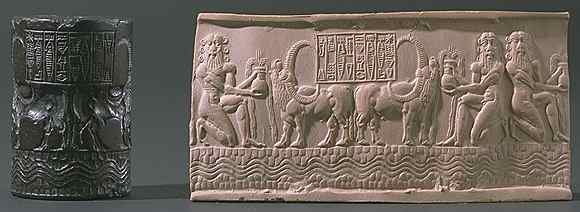
Sumerian cylinder seal line markings written in Akkadian (approx. 2250 BC, Louvre, Paris)
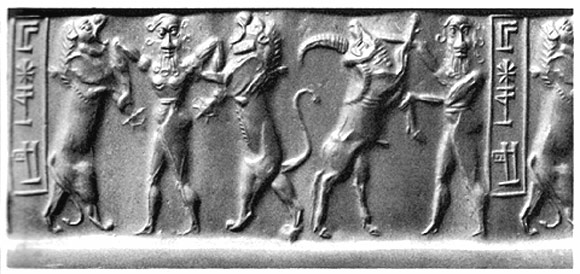
Gilgamesh and Enkidu struggle of the celestial bull and the lion (cylinder seal-print Approx. 2,400 BC, Walters Art Gallery, Baltimore)
The narrative is set of hieroglyphs read rebus. Rebus readings connote that the cylinder seal impressions on the proto-cuneiform tablet relate to the smelting furnace for metalware:
pasara 'quadrupeds' Rebus: pasra 'smithy' (Santali)
1.
a tiger, a fox on leashes held by a man kol 'tiger' Rebus: kol 'working in iron, alloys' lo ‘fox’ (WPah.) Rebus: lōha ʻmetalʼ (Pali)
a tiger, a fox on leashes held by a man kol 'tiger' Rebus: kol 'working in iron, alloys' lo ‘fox’ (WPah.) Rebus: lōha ʻmetalʼ (Pali)
2.
a procession of boars (rhinoceros?) and tiger in two rows kāṇṭā 'rhinoceros. Rebus: āṇḍa ‘tools, pots and pans and metal-ware’ (Gujarati)
3. a stalk/twig, sprout (or tree branch) kūdī,kūṭī bunch of twigs (Sanskrit) Rebus: kuṭhi ‘smelting furnace‘(Santali)
![]() Bull men contesting with lions. Cylinder seal and impression. Akkadian period. ca. 2334-2154 BCE. Marble. 28X26 mm. Seal No. 167 Morgan Library and Museum. A variant narrative adds hieroglyphs of an aquatic bird in flight. Hieroglyph: aquatic bird: karaṭa1 m. ʻ crow ʼ BhP., °aka -- m. lex. [Cf. karaṭu -- , karkaṭu -- m. ʻ Numidian crane ʼ, karēṭu -- , °ēṭavya -- , °ēḍuka -- m. lex., karaṇḍa2 -- m. ʻ duck ʼ lex: seekāraṇḍava -- ]Pk. karaḍa -- m. ʻ crow ʼ, °ḍā -- f. ʻ a partic. kind of bird ʼ; S. karaṛa -- ḍhī˜gu m. ʻ a very large aquatic bird ʼ; L. karṛā m., °ṛī f. ʻ the common teal ʼ.(CDIAL 2787). Allograph: karaṭa m. ʻ Carthamus tinctorius ʼ lex.Pk. karaḍa -- m. ʻ safflower ʼ, °ḍā -- f. ʻ a tree like the karañja ʼ; M. karḍī, °ḍaī f. ʻ safflower, Carthamus tinctorius and its seed ʼ.(CDIAL 2788). Rebus: karaḍā 'hardalloy of metals' (Marathi)
Bull men contesting with lions. Cylinder seal and impression. Akkadian period. ca. 2334-2154 BCE. Marble. 28X26 mm. Seal No. 167 Morgan Library and Museum. A variant narrative adds hieroglyphs of an aquatic bird in flight. Hieroglyph: aquatic bird: karaṭa1 m. ʻ crow ʼ BhP., °aka -- m. lex. [Cf. karaṭu -- , karkaṭu -- m. ʻ Numidian crane ʼ, karēṭu -- , °ēṭavya -- , °ēḍuka -- m. lex., karaṇḍa2 -- m. ʻ duck ʼ lex: seekāraṇḍava -- ]Pk. karaḍa -- m. ʻ crow ʼ, °ḍā -- f. ʻ a partic. kind of bird ʼ; S. karaṛa -- ḍhī˜gu m. ʻ a very large aquatic bird ʼ; L. karṛā m., °ṛī f. ʻ the common teal ʼ.(CDIAL 2787). Allograph: karaṭa m. ʻ Carthamus tinctorius ʼ lex.Pk. karaḍa -- m. ʻ safflower ʼ, °ḍā -- f. ʻ a tree like the karañja ʼ; M. karḍī, °ḍaī f. ʻ safflower, Carthamus tinctorius and its seed ʼ.(CDIAL 2788). Rebus: karaḍā 'hardalloy of metals' (Marathi)
a procession of boars (rhinoceros?) and tiger in two rows kāṇṭā 'rhinoceros. Rebus: āṇḍa ‘tools, pots and pans and metal-ware’ (Gujarati)
3. a stalk/twig, sprout (or tree branch) kūdī,kūṭī bunch of twigs (Sanskrit) Rebus: kuṭhi ‘smelting furnace‘(Santali)
 Bull men contesting with lions. Cylinder seal and impression. Akkadian period. ca. 2334-2154 BCE. Marble. 28X26 mm. Seal No. 167 Morgan Library and Museum. A variant narrative adds hieroglyphs of an aquatic bird in flight. Hieroglyph: aquatic bird: karaṭa1 m. ʻ crow ʼ BhP., °aka -- m. lex. [Cf. karaṭu -- , karkaṭu -- m. ʻ Numidian crane ʼ, karēṭu -- , °ēṭavya -- , °ēḍuka -- m. lex., karaṇḍa2 -- m. ʻ duck ʼ lex: seekāraṇḍava -- ]Pk. karaḍa -- m. ʻ crow ʼ, °ḍā -- f. ʻ a partic. kind of bird ʼ; S. karaṛa -- ḍhī˜gu m. ʻ a very large aquatic bird ʼ; L. karṛā m., °ṛī f. ʻ the common teal ʼ.(CDIAL 2787). Allograph: karaṭa m. ʻ Carthamus tinctorius ʼ lex.Pk. karaḍa -- m. ʻ safflower ʼ, °ḍā -- f. ʻ a tree like the karañja ʼ; M. karḍī, °ḍaī f. ʻ safflower, Carthamus tinctorius and its seed ʼ.(CDIAL 2788). Rebus: karaḍā 'hardalloy of metals' (Marathi)
Bull men contesting with lions. Cylinder seal and impression. Akkadian period. ca. 2334-2154 BCE. Marble. 28X26 mm. Seal No. 167 Morgan Library and Museum. A variant narrative adds hieroglyphs of an aquatic bird in flight. Hieroglyph: aquatic bird: karaṭa1 m. ʻ crow ʼ BhP., °aka -- m. lex. [Cf. karaṭu -- , karkaṭu -- m. ʻ Numidian crane ʼ, karēṭu -- , °ēṭavya -- , °ēḍuka -- m. lex., karaṇḍa2 -- m. ʻ duck ʼ lex: seekāraṇḍava -- ]Pk. karaḍa -- m. ʻ crow ʼ, °ḍā -- f. ʻ a partic. kind of bird ʼ; S. karaṛa -- ḍhī˜gu m. ʻ a very large aquatic bird ʼ; L. karṛā m., °ṛī f. ʻ the common teal ʼ.(CDIAL 2787). Allograph: karaṭa m. ʻ Carthamus tinctorius ʼ lex.Pk. karaḍa -- m. ʻ safflower ʼ, °ḍā -- f. ʻ a tree like the karañja ʼ; M. karḍī, °ḍaī f. ʻ safflower, Carthamus tinctorius and its seed ʼ.(CDIAL 2788). Rebus: karaḍā 'hardalloy of metals' (Marathi) 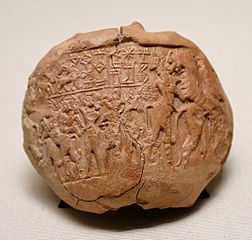 Cylinder seal impression.
Cylinder seal impression.Lugalanda, the dethroned monarch Lagas Seal (but Sarzec collection, Paris, Louvre)
 "Great Lyre" from Ur: Ht 33 cm. 2550 - 2400 BCE, royal tomb at Ur (cf. pg. 106 of J. Aruz and R. Wallenfels (eds.) 2003 Art of the First Cities).
"Great Lyre" from Ur: Ht 33 cm. 2550 - 2400 BCE, royal tomb at Ur (cf. pg. 106 of J. Aruz and R. Wallenfels (eds.) 2003 Art of the First Cities).
Cylinder Seal of bull-men flanking deity above sacred tree: mid 8th-7th Century BC – Metropolitan Museum of Art.
British Museum.org Lapis lazuli cylinder seal; contest scene - bull-man (full-face) in conflict with a lion. Antithetical group consisting of two bearded heroes (full-face) in the centre, who are naked except for a triple belt and who are protecting or are in conflict with, respectively, a human-headed bull (full-face) and a bull.

Cylinder seal: bull-man combating lion; nude hero combating water buffalo; inscription. Akkadian ca. 2250-2150 BCE. Mesopotamia. Albite stone. H. 3.4 cm dia. 2.3 cm. Met Museum. http://www.metmuseum.org/collection/the-collection-online/search/327600
Sumerian (Late Uruk/Jemdet Nasr Period) Black Stetatite Cylinder Seal http://art.thewalters.org/viewwoa.aspx?id=33263 In the two scenes on this cylinder seal, a heroic figure with heavy beard and long curls holds off two roaring lions, and another hero struggles with a water buffalo. The inscription in the panel identifies the owner of this seal as "Ur-Inanna, the farmer.
Girdled nude hero attacking water buffalo; bullman attacking lion; inscription. Kafaje,
Akkadian (ca. 2300 -2200 BC) Frankfort, Henri: Stratified Cylinder Seals from the Diyala Region. Oriental Institute Publications 72. Chicago: University of Chicago Press, no. 396.

Cylinder seal impression; scene representing mythological beings, bulls and lions in conflict (British Museum No. 89538)
Hypertext: blacksmith working with solder, pewter, brass
 Girdled nude hero attacking water buffalo; bull-man attacking lion; inscription. Kafaje, Akkadian.c. 2300 BCE, Iraq Museum, Baghdad. From a cylinder seal, in wo narrative frames flanking a star metonymy (Afer Fig. 1d in http://www.destiner.com/destiner_titles_dark_sect01_me.html)
Girdled nude hero attacking water buffalo; bull-man attacking lion; inscription. Kafaje, Akkadian.c. 2300 BCE, Iraq Museum, Baghdad. From a cylinder seal, in wo narrative frames flanking a star metonymy (Afer Fig. 1d in http://www.destiner.com/destiner_titles_dark_sect01_me.html)Six curls on hair: baTa 'six' Rebus: bhaTa 'furnace'
मेढा (p. 665) [ mēḍhā ]A twist or tangle arising in thread or cord, a curl or snarl. mẽṛhẽt, meḍ 'iron' (Mu.Ho.)
मेढ (p. 662) [ mēḍha ] The polar star मेढेमत (p. 665) [ mēḍhēmata ] n (मेढ Polar star, मत Dogma or sect.) A persuasion or an order or a set of tenets and notions amongst the Shúdra-people. Founded upon certain astrological calculations proceeding upon the North star. Hence मेढेजोशी or डौरीजोशी .(Marathi). Rebus: mẽṛhẽt, meḍ 'iron' (Mu.Ho.)
The narrative of metalwork is explained as metonymy. A horned person ligatured to the hindpart of a bull: ḍhaṅgaru, ḍhiṅgaru m. ʻlean emaciated beastʼ(Sindhi) Rebus: dhangar ‘blacksmith’ (Maithili)
His life-activity is in wrestling with lion (hieroglyph): אַרְיֵה (aryeh) 'lion' (Hebrew)Rebus: āra, āramBrass (Tamil) आरः रम् [आ-ऋ-घञ्] 1 Brass; ताम्रारकोष्ठां परिखादुरा- सदाम् Bhāg.1.41.2. Oxide of iron.( The metonymy is thus a rebus rendering of alloy metal)(Samskritam).
Hieroglyph: rã̄go 'buffalo': raṅku m. ʻ a species of deer ʼ Vās., °uka -- m. Śrīkaṇṭh.Ku. N. rã̄go ʻ buffalo bull ʼ? (CDIAL 10559) Rebus: rã̄gā m. ʻ pewter, tin ʼ (Punjabi)rāṅgā ʻ solder, spelter ʼ (Oriya)
S. Kalyanaraman
Sarasvati Research Center
September 2, 2015
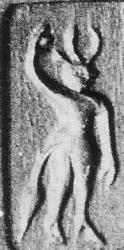


![clip_image033[4]](http://kalyan97.files.wordpress.com/2007/06/clip-image0334-thumb.jpg?w=71&h=44)
